How Can Odors Be Measured? An Overview of Methods and Their Applications
Abstract
:1. Introduction
- Dynamic olfactometry;
- Chemical analysis (with speciation or non-specific);
- Gas chromatography-olfactometry (GC-O);
- Tracer analysis;
- Instrumental odor monitoring by e-noses;
- Field inspection;
- Field olfactometry; and
- Citizen science.
2. Overview of Odor Impact Assessment Methods
2.1. General Schematization of Odor Impact Assessment Methods
- Emissions: For measuring odors at emission sources; and
- Receptors: For measuring odors in ambient air, directly where citizens are located and where complaints come from.
2.2. Dynamic Olfactometry
2.2.1. Brief Description of the Method
2.2.2. Applicability and Limitations
2.2.3. Examples of Applications
2.3. Chemical Analysis with Speciation
2.3.1. Brief Description of the Method
2.3.2. Applicability and Limitations
2.3.3. Examples of Applications
2.4. Gas Chromatography-Olfactometry GC-O
2.4.1. Brief Description of the Method
- Detection frequency:The same sample is analyzed by a panel of assessors (6–12 panelists) in order to provide the percentage of people who detect the odor compound at a given retention time. Each odor can be evaluated using the nasal impact frequency (NIF) or surface of nasal impact frequency (SNIF) values. The NIF is set at one when each of the evaluators senses a given odor and zero when no one senses any odor at a given retention time. The NIF value corresponds to the peak height of the olfactometric signal while the SNIF value represents the peak areas obtained by multiplying the frequency percentage by the duration.
- Dilution to threshold:Dilution to threshold methods provide a quantitative description of the odor potential of a given compound based on the ratio between its concentration in the sample and its sensory threshold in air. These methods involve the preparation of a dilution series of samples, using two-fold, three-fold, five-fold, or 10-fold dilution levels and analyzing them by GC-O. The panelist indicates under which dilution the compound can still be sensed and describes the type of smell. The most common dilution methods are aroma extract dilution analysis (AEDA) and combined hedonic aroma response measurement (CharmAnalyisTM). AEDA measures the highest sample dilution at which the odor is still detectable (flavor dilution factor, FD). CharmAnalyisTM records the duration of odors and generates chromatographic peaks.
- Direct intensity:Direct intensity methods measure the intensity and duration of odors using different types of quantitative scales: Category scales or unstructured scales. These methods include a single time-averaged measurement registered after the elution of the analyte, or a dynamic measurement, where the appearance of the odor, its maximum intensity, and the decline are recorded continuously (OSME). In the first case, the panelist assigns a value from a previously defined scale to each detected compound while in the second case, an olfactogram, which similar to conventional chromatograms, is obtained, in which the peak corresponds to the maximum intensity and width of the odor duration.
2.4.2. Applicability and Limitations
2.4.3. Examples of Applications
2.5. Chemical Analysis—Non-Specific
2.5.1. Brief Description of the Method
2.5.2. Applicability and Limitations
2.5.3. Examples of Applications
2.6. Chemical Analysis—Single Gases
2.6.1. Brief Description of the Method
2.6.2. Applicability and Limitations
2.6.3. Examples of Applications
2.7. Instrumental Odor Monitoring (E-Noses)
2.7.1. Brief Description of the Method
- Gas detection system: This is an array of n gaseous sensors, which may differ in type and operational temperature, housed into a chemically inert box, which respond to the presence of VOCs with variations of their chemical-physical properties [66,67]. The gas detection system mimics the function of human olfactory receptors.
- Data processing unit: This system, as the human olfactory bulb, compresses the transient responses of the sensors, eliminates signal noise, and extracts features relevant for pattern recognition.
- Classification or pattern recognition: A classification algorithm identifies odors based on a dataset that must have been previously stored. In particular, when presented with an unidentified sample, the classification assigns to it a class label by comparing its fingerprint with those compiled during the training.
- Signal pre-processing and feature extraction;
- Dimensionality reduction; and
- Classification or clustering.
2.7.2. Applicability and Limitations
2.7.3. Examples of Applications
2.8. Field Inspection
2.8.1. Brief Description of the Method
- Grid method (EN 16841-1:2016) [6]: This uses direct assessment of ambient air by panel members to characterize odor exposure in a defined assessment area; and
- Plume method (EN 16841-2:2016) [7]: This determines the extent of the downwind odor plume of a defined source under specific meteorological conditions.
2.8.2. Applicability and Limitations
2.8.3. Examples of Applications
2.9. Field Olfactometry
2.9.1. Brief Description of the Method
2.9.2. Applicability and Limitations
2.9.3. Examples of Applications
2.10. Citizen Science
2.10.1. Brief Description of the Method
2.10.2. Applicability and Limitations
2.10.3. Examples of Applications
3. Comparison of Different Odor Measurement Techniques
4. Discussion and Conclusions
Author Contributions
Funding
Conflicts of Interest
References
- Henshaw, P.; Nicell, J.; Sikdar, A. Parameters for the assessment of odour impacts on communities. Atmos. Environ. 2006, 40, 1016–1029. [Google Scholar] [CrossRef]
- Aatamila, M.; Verkasalo, P.K.; Korhonen, M.J.; Suominen, A.L.; Hirvonen, M.R.; Viluksela, M.K.; Nevalainen, A. Odour annoyance and physical symptoms among residents living near waste treatment centres. Environ. Res. 2011, 111, 164–170. [Google Scholar] [CrossRef] [PubMed]
- McGinley, A.M.; McGinley, M.C. Developing a Credible Odor Monitoring Program; American Society of Agricultural Engineers (ASAE): Ottawa, ON, Canada, 2004. [Google Scholar]
- Heroux, M.; Page, T.; Gelinas, C.; Guy, C. Evaluating odour impacts from landfilling and composting site: Involving citizens in the monitoring. Water Sci. Technol. 2004, 50, 131–137. [Google Scholar] [CrossRef] [PubMed]
- Standard EN 13725:2003. Air Quality-Determination of Odour Concentration by Dynamic Olfactometry; CEN: Brussels, Belgium, 2003. [Google Scholar]
- Standard EN 16481-1:2016. Ambient Air-Determination of Odour in Ambient Air by Using Field Inspection-Part 1: Grid Method; CEN: Brussels, Belgium, 2016. [Google Scholar]
- Standard EN 16481-2:2016. Ambient Air-Determination of Odour in Ambient Air by Using Field Inspection-Part 2: Plume Method; CEN: Brussels, Belgium, 2016. [Google Scholar]
- Lee, H.D.; Jeon, S.-B.; Choi, W.J.; Lee, S.S.; Lee, M.H.; Oh, K.J. A novel assessment of odor sources using instrumental analysis combined with resident monitoring records for an industrial area in Korea. Atmos. Environ. 2013, 74, 277–290. [Google Scholar] [CrossRef]
- Haklay, M. Chapter 4-Toward inclusive and effective citizen science. In Citizen Science and Policy: A European Perspective; Tyson, E., Bowser, A., Rejeski, D., Eds.; Woodrow Wilson International Center for Scholars: Washington, DC, USA, 2015; pp. 54–59. [Google Scholar]
- McGinley, M.A.; McGinley, C.M. Developing a credible odor monitoring program. In Proceedings of the ASAE Annual Meeting, St. Joseph, MI, USA, 1–4 August 2004. [Google Scholar]
- Tyndall, J.C.; Grudens-Schuck, N.; Harmon, J.D.; Hoff, S.J. Social approval of the community assessment model for odor dispersal: Results from a survey. Environ. Manag. 2012, 50, 315–328. [Google Scholar] [CrossRef]
- Piringer, M.; Schauberger, G.; Petz, E.; Knauder, W. Comparison of two peak-to-mean approaches for use in odour dispersion models. Water Sci. Technol. 2012, 66, 1498–1501. [Google Scholar] [CrossRef]
- Brancher, M.; Knauder, W.; Piringer, M.; Schauberger, G. Temporal variability in odour emissions: To what extent this matters for the assessment of annoyance using dispersion modelling. Atmos. Environ. X 2019, 5, 100054. [Google Scholar] [CrossRef]
- Wu, C.; Brancher, M.; Yang, F.; Liu, J.; Qu, C.; Schauberger, G.; Piringer, M. A comparative analysis of methods for determining odour-related separation distances around a dairy farm in Beijing, China. Atmosphere 2019, 10, 231. [Google Scholar] [CrossRef] [Green Version]
- Piringer, M.; Petz, E.; Groehn, I.; Schauberger, G. A sensitivity study of separation distances calculated with the Austrian Odour Dispersion Model (AODM). Atmos. Environ. 2013, 67, 461–462. [Google Scholar] [CrossRef]
- Capelli, L.; Sironi, S.; Del Rosso, R.; Centola, P.; Rossi, A.; Austeri, C. Odour impact assessment in urban areas: Case study of the city of Terni. Procedia Environ. Sci. 2011, 4, 151–157. [Google Scholar] [CrossRef] [Green Version]
- Mahin, T.D. Comparison of different approaches used to regulate odours around the world. Water Sci. Technol. 2001, 44, 87–102. [Google Scholar] [CrossRef] [PubMed]
- Brancher, M.; Griffiths, K.D.; Franco, D.; de Melo Lisboa, H. A review of odour impact criteria in selected countries around the world. Chemosphere 2017, 168, 1531–1570. [Google Scholar] [CrossRef] [PubMed]
- Capelli, L.; Sironi, S.; Del Rosso, R.; Guillot, J.M. Measuring odours in the environment vs. Dispersion modelling: A review. Atmos. Environ. 2013, 79, 731–743. [Google Scholar] [CrossRef]
- Conti, C.; Guarino, M.; Bacenetti, J. Measurement techniques and models to assess odor annoyance: A review. Environ. Int. 2020, 134, 105261. [Google Scholar] [CrossRef]
- Gutiérrez, M.C.; Martín, M.A.; Pagans, E.; Vera, L.; García-Olmo, J.; Chica, A.F. Dynamic olfactometry and GC–TOF/MS to monitor the efficiency of an industrial biofilter. Sci. Total Environ. 2015, 512–513, 572–581. [Google Scholar]
- Nicolas, J.; Craffe, F.; Romain, A.C. Estimation of odor emission rate from landfill areas using the sniffing team method. Waste Manag. 2006, 26, 1259–1269. [Google Scholar] [CrossRef] [Green Version]
- Leyris, C.; Guillot, J.M.; Fanlo, J.L.; Pourtier, L. Comparison and development of dynamic flux chambers to determine odorous compound emission rates from area sources. Chemosphere 2005, 59, 415–421. [Google Scholar] [CrossRef]
- Capelli, L.; Sironi, S.; Del Rosso, R. Odor sampling: Techniques and strategies for the estimation of odor emission rates from different source types. Sensors 2013, 13, 938–955. [Google Scholar] [CrossRef] [Green Version]
- Lucernoni, F.; Capelli, L.; Sironi, S. Odour sampling on passive area sources: Principles and methods. Chem. Eng. Trans. 2016, 54. [Google Scholar] [CrossRef]
- Sironi, S.; Capelli, L.; Del Rosso, R. Odor emissions. Reference Module in Chemistry, Molecular Sciences and Chemical Engineering; Elsevier: Amsterdam, The Netherlands, 2014. [Google Scholar]
- Sówka, I.; Miller, U.; Grzelka, A. The application of dynamic olfactometry in evaluating the efficiency of purifying odorous gases by biofiltration. Environ. Prot. Eng. 2017, 43, 233–242. [Google Scholar]
- Sironi, S.; Capelli, L.; Céntola, P.; Del Rosso, R.; Pierucci, S. Odour impact assessment by means of dynamic olfactometry, dispersion modelling and social participation. Atmos. Environ. 2010, 44, 354–360. [Google Scholar] [CrossRef]
- Romanik, E.; Bezyk, Y.; Pawnuk, M.; Miller, U.; Grzelka, A. Influence of the variability of the odor emission rate on its impact range: A case study of the selected industrial source. E3S Web Conf. 2019, 100, 00070. [Google Scholar] [CrossRef] [Green Version]
- Audouin, V.; Bonnet, F.; Vickers, Z.M.; Reineccius, G.A. Limitations in the use of odor activity values to determine important odorants in foods. In Gas Chromatography-Olfactometry; American Chemical Society: Washington, DC, USA, 2001; Volume 782, pp. 156–171. [Google Scholar]
- Jiang, G.; Melder, D.; Keller, J.; Yuan, Z. Odor emissions from domestic wastewater: A review. Crit. Rev. Environ. Sci. Technol. 2017, 47, 1581–1611. [Google Scholar] [CrossRef]
- Dravnieks, A.; Jarke, F. Odor threshold measurement by dynamic olfactometry: Significant operational variables. J. Air Pollut. Control 1980, 30, 1284–1289. [Google Scholar] [CrossRef] [Green Version]
- Jarauta, I.; Ferreira, V.; Cacho, J.F. Synergic, additive and antagonistic effects between odorants with similar odour properties. Dev. Food Sci. 2006, 43, 205–208. [Google Scholar]
- Pojmanova, P.; Ladislavova, N.; Skerikova, V.; Kania, P.; Urban, S. Human Scent Samples for Chemical Analysis; Chemical Papper; Springer: Berlin/Heidelberg, Germany, 2019; pp. 1–11. [Google Scholar]
- Ricon, C.A.; De Guardia, A.; Couvert, A.; Le Roux, S.; Soutrel, I.; Daumoin, M.; Benoist, J.C. Chemical and odor characterization of gas emissions released during composting of solid waste digestates. J. Environ. Manag. 2019, 233, 39–53. [Google Scholar] [CrossRef]
- Fisher, R.M.; Barczak, R.J.; Suffet, I.H.M.; Hayes, J.E.; Stuetz, R.M. Framework for the use of odour wheels to manage odours throughout wastewater biosolids processing. Sci. Total Environ. 2018, 634, 214–223. [Google Scholar] [CrossRef]
- Munoz, R.; Sivret, E.C.; Parcsi, G.; Lebrero, R.; Wang, X.; Suffet, I.H.; Stuetz, R.M. Monitoring techniques for odor abatement assessment. Water Res. 2010, 44, 5129–5149. [Google Scholar] [CrossRef]
- Gostelow, P.; PArson, S.A.; Stuetz, R.M. Odour measurements for sewage treatment works. Water Res. 2001, 35, 579–597. [Google Scholar] [CrossRef]
- Font, X.; Artola, A.; Sanchez, A. Detection, compostion and treatment of volatile organic compounds from waste treatment plant. Sensors 2011, 11, 4043–4059. [Google Scholar] [CrossRef] [Green Version]
- Mao, I.F.; Tsai, C.J.; Shen, S.H.; Lin, T.F.; Chen, W.K.; Chen, M.L. Critical components of odors in evaluationg the performance of food waste composting plants. Sci. Total Environ. 2006, 370, 323–329. [Google Scholar] [CrossRef]
- D’Imporzano, G.; Crivelli, F.; Adani, F. Biological activity influences odor molecules production measured by electronic noses during food-waste high-rate composting. Sci. Total Environ. 2008, 402, 278–284. [Google Scholar] [CrossRef] [PubMed]
- Murphy, K.R.; Parcsi, G.; Stuetz, R.M. Non-methane volatile organic compounds predict odor emitted from five tunnel ventilated broiler sheds. Chemosphere 2014, 95, 423–432. [Google Scholar] [CrossRef] [PubMed]
- Wu, C.; Liu, J.; Zhao, P.; Li, W.; Yan, L.; Piringer, M.; Schauberger, G. Evaluation of the chemical composition and correlation between the calculated and measured odour concentration of odorous gases from a landfill in Beijing, China. Atmos. Environ. 2017, 164, 337–347. [Google Scholar] [CrossRef]
- Gonzalez, D.; Colon, J.; Sanchez, A.; Gabriel, D. A systematic study on the VOCs characterization and odour emissions in a full-scale sewage sludge composting plant. J. Hazard. Mater. 2019, 373, 733–740. [Google Scholar] [CrossRef] [PubMed]
- Byliński, H.; Kolasińska, P.; Dymerski, T.; Gębicki, J.; Namieśnik, J. Determination of odour concentration by TD-GCxGC-TOF-MS and field olfactometry techniques. Mon. Chem. Chem. Mon. 2017, 148, 1651–1659. [Google Scholar] [CrossRef] [PubMed] [Green Version]
- Delahunty, C.M.; Eyres, G.; Dufour, J.P. Gas chromatography-olfactometry. J. Sep. Sci. 2006, 29, 2107–2125. [Google Scholar] [CrossRef] [PubMed]
- Brattoli, M.; Cisternino, E.; Dambruoso, P.R.; De Gennaro, G.; Giungato, P.; Mazzone, A.; Palmisani, J.; Tutino, M. Gas chromatography analysis with olfactometric detection (GC-O) as a useful methodology for chemical characterization of odorous compounds. Sensors 2013, 13, 16759–16800. [Google Scholar] [CrossRef] [Green Version]
- Zhang, S.; Cai, L.; Koziel, J.A.; Hoff, S.J.; Schmidt, D.R.; Clanton, C.J.; Jacobson, L.D.; Parker, D.B.; Heber, A.J. Field air sampling and simultaneous chemical and sensory analysis of livestock odorants with sorbent tubes and gc–ms/olfactometry. Sens. Actuators B Chem. 2010, 146, 427–432. [Google Scholar] [CrossRef]
- Zhang, S.; Koziel, J.A.; Cai, L.; Hoff, S.J.; Heathcote, K.Y.; Chen, L.; Jacobson, L.D.; Akdeniz, N.; Hetchler, B.P.; Parker, D.B.; et al. Odor and odorous chemical emissions from animal buildings: Part 5. Simultaneous chemical and sensory analysis with gas chromatography-mass spectrometry-olfactometry. Trans. ASABE 2015, 58, 1349–1359. [Google Scholar]
- Chaulya, S.K.; Prasad, G.M. Chapter 3-Gas sensors for underground mines and hazardous areas. In Sensing and Monitoring Technologies for Mines and Hazardous Areas; Elsevier: Amsterdam, The Netherlands, 2016; pp. 161–212. [Google Scholar]
- Stauffer, E.; Dolan, J.A.; Newman, R. Chapter 5-Detection of ignitable liquid residues at fire scenes. In Fire Debris Analysis; Elsevier: Burlington, NJ, USA, 2008; pp. 131–161. [Google Scholar]
- Chambers, A.K.; Strosher, M.; Wootton, T.; Moncrieff, J.; McCready, P. Direct measurement of fugitive emissions of hydrocarbons from a refinery. J. Air Waste Manag. Assoc. 2008, 58, 1047–1056. [Google Scholar] [CrossRef]
- Fredenslund, A.M.; Scheutz, C.; Kjeldsen, P. Tracer methods to measure landfill gas emissions from leachate collection systems. Waste Manag. 2010, 30, 2146–2152. [Google Scholar] [CrossRef] [PubMed]
- Di Bella, G.; Di Trapani, D.; Viviani, G. Evaluation of methane emissions from Palermo municipal landfill: Comparison between fiedl measurements and models. Waste Manag. 2011, 31, 1820–1826. [Google Scholar] [CrossRef] [PubMed]
- Kormi, T.; Mhadhebi, S.; Bel Hadj Ali, N.; Abichou, T.; Green, R. Estimation of fugitive landfill methane emissions using surface emission monitoring and genetic algorithms optimization. Waste Manag. 2018, 72, 313–328. [Google Scholar] [CrossRef]
- Antuna-Jiménez, D.; Díaz-Díaz, G.; Blanco-López, M.C.; Lobo-Castañón, M.J.; Miranda-Ordieres, A.J.; Tunon-Blanco, P. Chapter 1-Molecularly imprinted electrochemical sensors: Past, present, and future. In Molecularly Imprinted Sensors; Li, S., Ge, Y., Piletsky, S.A., Lunec, J., Eds.; Elsevier: Amsterdam, The Netherlands, 2012; pp. 1–34. [Google Scholar]
- Nabais, R. Odours in the Food Industry; Springer: New York, NY, USA, 2006. [Google Scholar]
- Roetzer, H.; Muehldorf, V.; Riesing, J. Measurement of the odor impact of a waste deposit using the SF6-tracer method (OEFZS--4733). In Proceedings of the 2nd International Symposium on Environmental Contamination in Central and Eastern Europe, Budapest, Hungary, 20–23 September 1994. [Google Scholar]
- Cangialosi, F.; Intini, G.; Colucci, D. On line monitoring of odour nuisance at a sanitary landfill for non-hazardous waste. Chem. Eng. Trans. 2018, 68, 127–132. [Google Scholar]
- Stuetz, R.M.; Fenner, R.A.; Engin, G. Assessment of odours from sewage treatment works by an electronic nose, H2S analyzer and olfactometry. Water Res. 1999, 33, 453–461. [Google Scholar] [CrossRef]
- Qu, G.; Omotoso, M.M.; el-Din, M.G.; Feddes, J.J.R. Development of an integrated sensor to measure odors. Environ. Monit. Assess. 2008, 144, 277–283. [Google Scholar] [CrossRef]
- Heaney, C.D.; Wing, S.; Campbell, R.L.; Caldwell, D.; Hopkins, B.; Richardson, D.; Yeatts, K. Relation between malodor, ambient hydrogen sulfide, and health in a community bordering a landfill. Environ. Res. 2011, 111, 847–852. [Google Scholar] [CrossRef] [Green Version]
- Blanes-Vidal, V.; Nadimi, E.S.; Ellermann, T.; Andersen, H.V.; Løfstrøm, P. Perceived annoyance from environmental odors and association with atmospheric ammonia levels in non-urban residential communities: A cross-sectional study. Environ. Health 2012, 11, 27. [Google Scholar] [CrossRef] [Green Version]
- Ramgir, N.S. Electronic nose based on nanomaterials: Issues, challenges, and prospects. ISRN Nanomater. 2013, 2013, 21. [Google Scholar] [CrossRef] [Green Version]
- Hu, W.; Wan, L.; Jian, Y.; Ren, C.; Jin, K.; Su, X.; Bai, X.; Haick, H.; Yao, M.; Wu, W. Electronic noses: From advanced materials to sensors aided with data processing. Adv. Mater. Technol. 2019, 4, 1800488. [Google Scholar] [CrossRef] [Green Version]
- Lantto, V.; Rantala, T.T.; Rantala, T.S. Atomistic understanding of semiconductor gas sensors. J. Eur. Ceram. Soc. 2001, 21, 1961–1965. [Google Scholar] [CrossRef]
- Elosua, C.; Matias, I.R.; Bariain, C.; Arregui, F.J. Volatile organic compound optical fiber sensors: A review. Sensors 2006, 6, 1440–1465. [Google Scholar] [CrossRef] [Green Version]
- Aguilera, T.; Lozano, J.; Paredes, J.; Álvarez, F.; Suárez, J. Electronic nose based on independent component analysis combined with partial least squares and artificial neural networks for wine prediction. Sensors 2012, 12, 8055–8072. [Google Scholar] [CrossRef]
- Zhang, L.; Tian, F.; Nie, H.; Dang, L.; Li, G.; Ye, Q.; Kadri, C. Classification of multiple indoor air contaminants by an electronic nose and a hybrid support vector machine. Sens. Actuators B Chem. 2012, 174, 114–125. [Google Scholar] [CrossRef]
- Pardo, M.; Sberveglieri, G. Classification of electronic nose data with support vector machines. Sens. Actuators B Chem. 2005, 107, 730–737. [Google Scholar] [CrossRef]
- Men, H.; Fu, S.; Yang, J.; Cheng, M.; Shi, Y.; Liu, J. Comparison of SVM, RF and ELM on an electronic nose for the intelligent evaluation of paraffin samples. Sensors 2018, 18, 285. [Google Scholar] [CrossRef] [Green Version]
- Güney, S.; Atasoy, A. Classification of n-butanol concentrations with k-nn algorithm and ann in electronic nose. In Proceedings of the International Symposium on Innovations in Intelligent Systems and Applications (INISTA), Istanbul, Turkey, 15–18 June 2011; pp. 138–142. [Google Scholar]
- Capelli, L.; Sironi, S.; Del Rosso, R. Electronic noses for environmental monitoring applications. Sensors 2014, 14, 19979–20007. [Google Scholar] [CrossRef]
- Pan, L.; Yang, S.X. An electronic nose network system for online monitoring of livestock farm odors. IEEE/ASME Trans. Mechatron. 2009, 14, 371–376. [Google Scholar] [CrossRef]
- Adam, G.; Lemaigre, S.; Goux, X.; Delfosse, P.; Romain, A.C. electronic nose tehcnology for reactor state and biogas quality assessment in aerobic digestion. In Proceedings of the 2nd Conference on “Monitoring & Process Control of Anaerobic Digestion Plants”, Leipzig, Germany, 17–18 March 2015. [Google Scholar]
- Figueredo, S.; Stentiford, E. Evaluating the potential of an electronic nose for detecting the onset of anaerobic conditions during composting. Bioprocess Solid Waste Sludge 2002, 2, 1–17. [Google Scholar]
- Delgado-Rodríguez, M.; Ruiz-Montoya, M.; Giraldez, I.; López, R.; Madejón, E.; Díaz, M.J. Use of electronic nose and GC-MS in detection and monitoring some voc. Atmos. Environ. 2012, 51, 278–285. [Google Scholar] [CrossRef]
- Sironi, S.; Capelli, L.; Céntola, P.; Del Rosso, R.; Grande, M.I. Continuous monitoring of odours from a composting plant using electronic noses. Waste Manag. 2007, 27, 389–397. [Google Scholar] [CrossRef] [PubMed]
- Deshmukh, S.; Bandyopadhyay, R.; Bhattacharyya, N.; Pandey, R.A.; Jana, A. Application of electronic nose for industrial odors and gaseous emissions measurement and monitoring–an overview. Talanta 2015, 144, 329–340. [Google Scholar] [CrossRef] [PubMed]
- Licen, S.; Barbieri, G.; Fabbris, A.; Briguglio, S.C.; Pillon, A.; Stel, F.; Barbieri, P. Odor control map: Self organizing map built from electronic nose signals and integrated by different instrumental and sensorial data to obtain an assessment tool for real environmental scenarios. Sens. Actuators B Chem. 2018, 263, 476–485. [Google Scholar] [CrossRef]
- Orzi, V.; Riva, C.; Scaglia, B.; D’Imporzano, G.; Tambone, F.; Adani, F. Anaerobic digestion coupled with digestate injection reduced odour emissions from soil during manure distribution. Sci. Total Environ. 2018, 621, 168–176. [Google Scholar] [CrossRef] [PubMed]
- Bax, C.; Li Voti, M.; Sironi, S.; Capelli, L. Application and performance verification of electronic noses for landfill odour monitoring. In Proceedings of the 17th Simposio Internazionale Sulla Gestione dei Rifiuti e Sulle Discariche, Cagliari, Italy, 30 September–4 October 2019. [Google Scholar]
- Cipriano, D.; Capelli, L. Evolution of electronic noses form research objects to engineered environmental odour monitoring systems: A review of standardization approaches. Biosensors 2019, 9, 75. [Google Scholar] [CrossRef] [PubMed] [Green Version]
- Mannebeck, B.; Mannebeck, C.; Mannebeck, D.; Hauschildt, H.; Van Den Burg, A. Field inspections according to prEN16841-1:2015 in a naturally evolved neighborhood of industry and living areas. State-of-the-art-technology of a comprehensive data collection, interaction of different sources and effects on the perceiving citizens. Chem. Eng. Trans. 2016, 54, 181–186. [Google Scholar]
- Yaacof, N.; Qamaruzzaman, N.; Yusup, Y. Comparison method of odour impact evaluation using calpuff dispersion modelling and on-site monitoring. Eng. Herit. J. 2017, 1, 1–5. [Google Scholar] [CrossRef]
- Oettl, D.; Kropsch, M.; Mandl, M. Odour assessment in the vicinity of a pig-fattening farm using field inspections (EN 16841-1) and dispersion modelling. Atmos. Environ. 2018, 181, 54–60. [Google Scholar] [CrossRef]
- Capelli, L.; Sironi, S. Combination of field inspection and dispersion modelling to estimate odour emissions from an Italian landfill. Atmos. Environ. 2018, 191, 273–290. [Google Scholar] [CrossRef] [Green Version]
- McGinley, M.A.; McGinley, C.M. Comparison of field olfactometers in a controlled chamber using hydrogen sulfide as the test odorant. Water Sci. Technol. A J. Int. Assoc. Water Pollut. Res. 2004, 50, 75–82. [Google Scholar] [CrossRef]
- Barczak, R.; Kuling, A. Odour monitoring of a municipal wastewater treatment plant in poland by field olfactometry. Chem. Eng. Trans. 2016, 54, 331–336. [Google Scholar]
- Vieira, M.M.; Guillot, J.M.; Belli Fiho, P.; Romain, A.C.; Adam, G.; Delva, J.; Baron, M.; Van Elst, T. Can we combine field olfactometry and plume method measurements? In Proceedings of the 7th IWA conference on odours and air emissions, Warsaw, Poland, 25–27 September 2017. [Google Scholar]
- Badach, J.; Kolasinska, P.; Paciorek, M.; Wojnowski, W.; Dymerski, T.; Gebicki, J.; Dymnicka, M.; Namiesnik, J. A case study of odour nuisance evaluation in the context of integrated urban planning. J. Environ. Manag. 2018, 213, 417–424. [Google Scholar] [CrossRef] [PubMed]
- Heigl, F.; Kieslinger, B.; Paul, K.T.; Uhlik, J.; Dörler, D. Opinion: Toward an international definition of citizen science. Proc. Natl. Acad. Sci. USA 2019, 116, 8089–8092. [Google Scholar] [CrossRef] [PubMed] [Green Version]
- Sówka, I.; Miller, U.; Bezyk, Y.; Nych, A.; Grzelka, A.; Dąbrowski, L. Application of field inspections and odour observation diaries in the assessment of air quality and odour in urban areas. E3S Web Conf. 2018, 45, 00086. [Google Scholar] [CrossRef]
- Eltarkawe, M.; Miller, S. Industrial odor source identification based on wind direction and social participation. Int. J. Environ. Res. Public Health 2019, 16, 1242. [Google Scholar] [CrossRef] [PubMed] [Green Version]
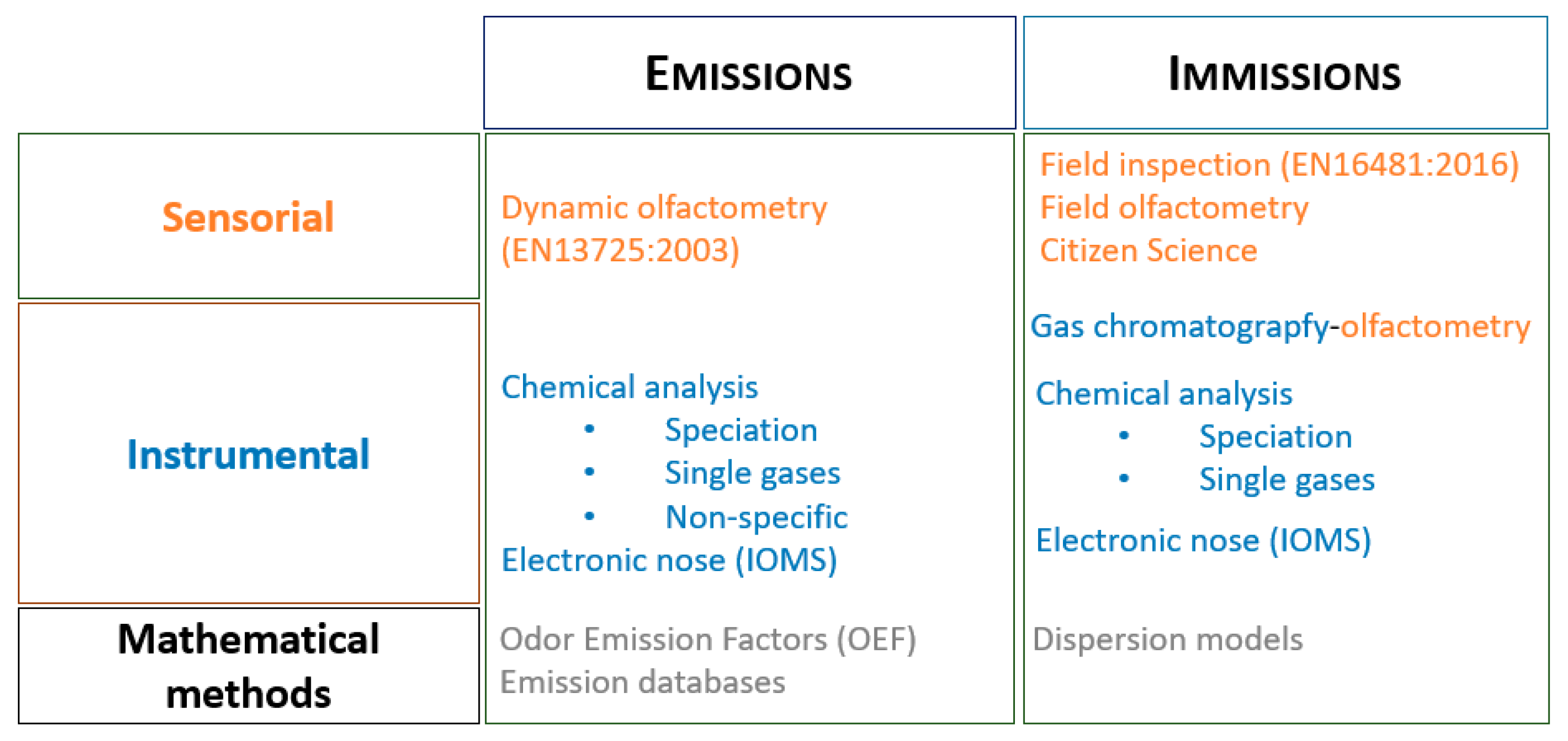
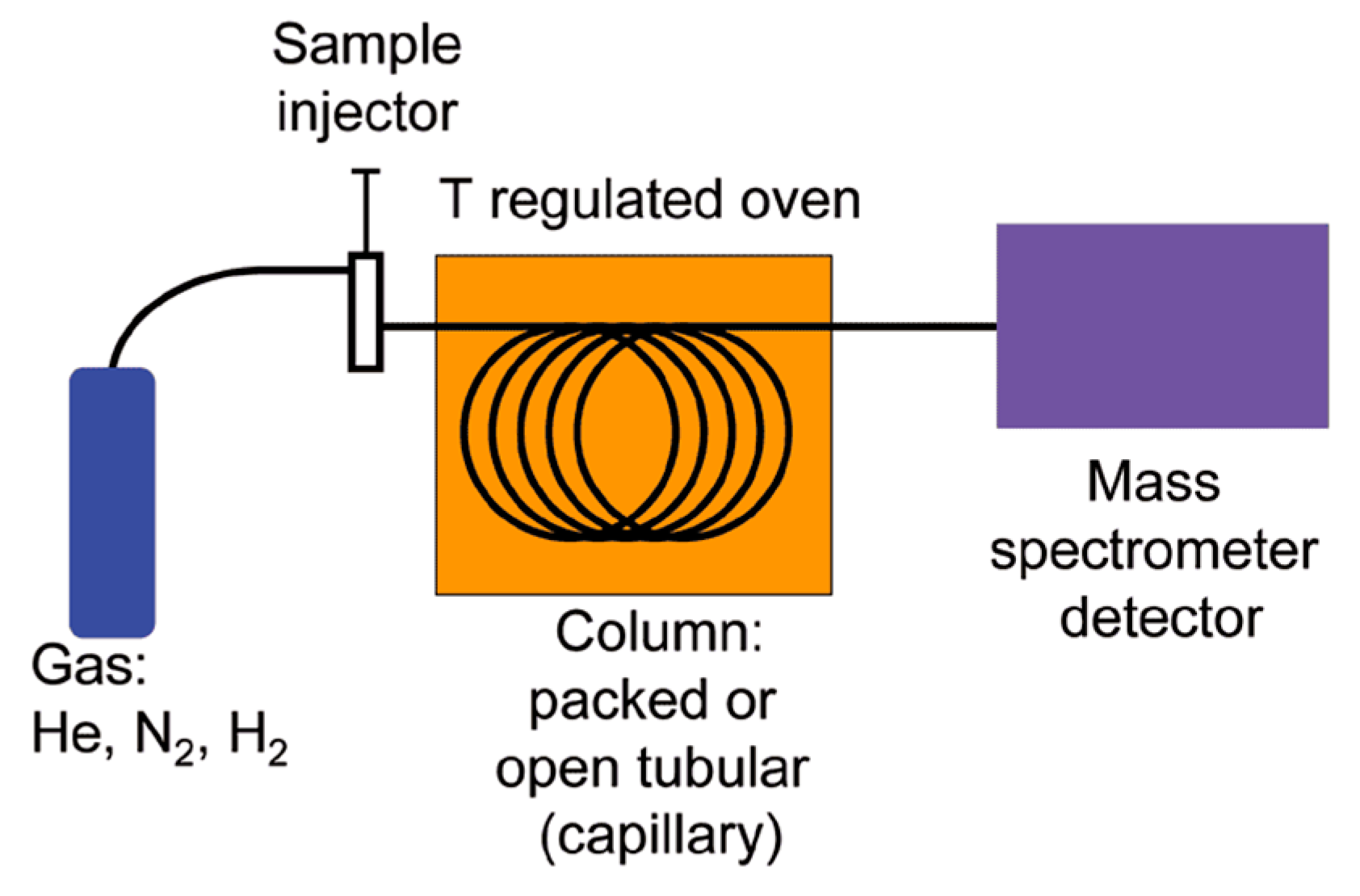
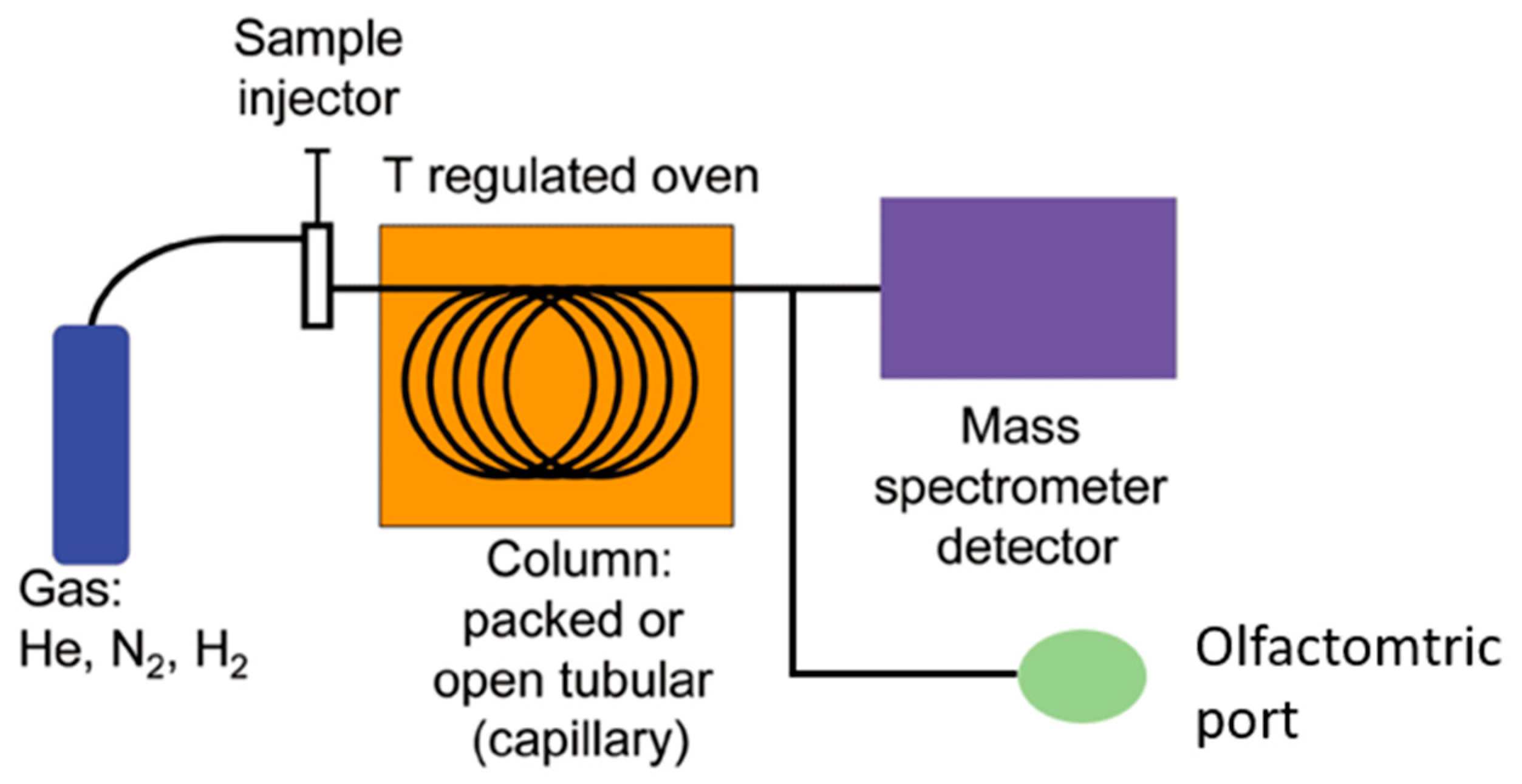
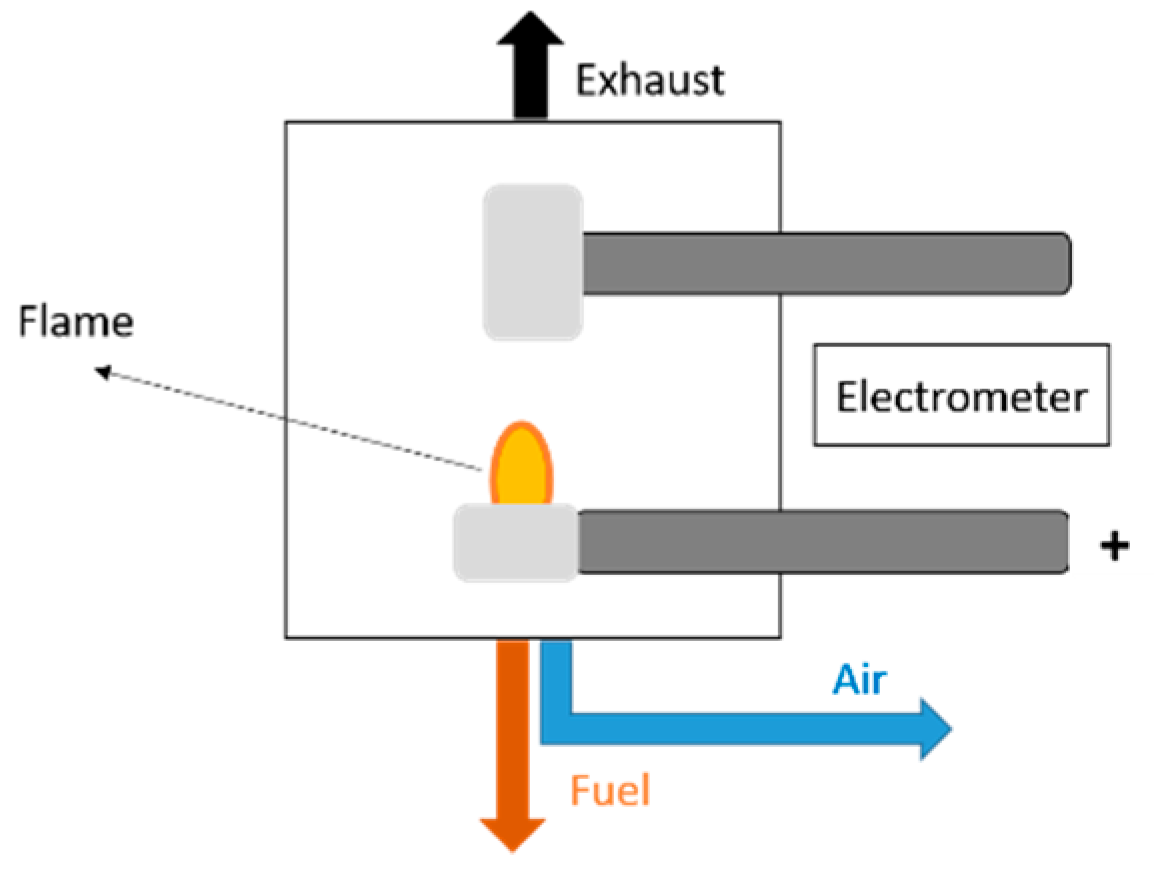
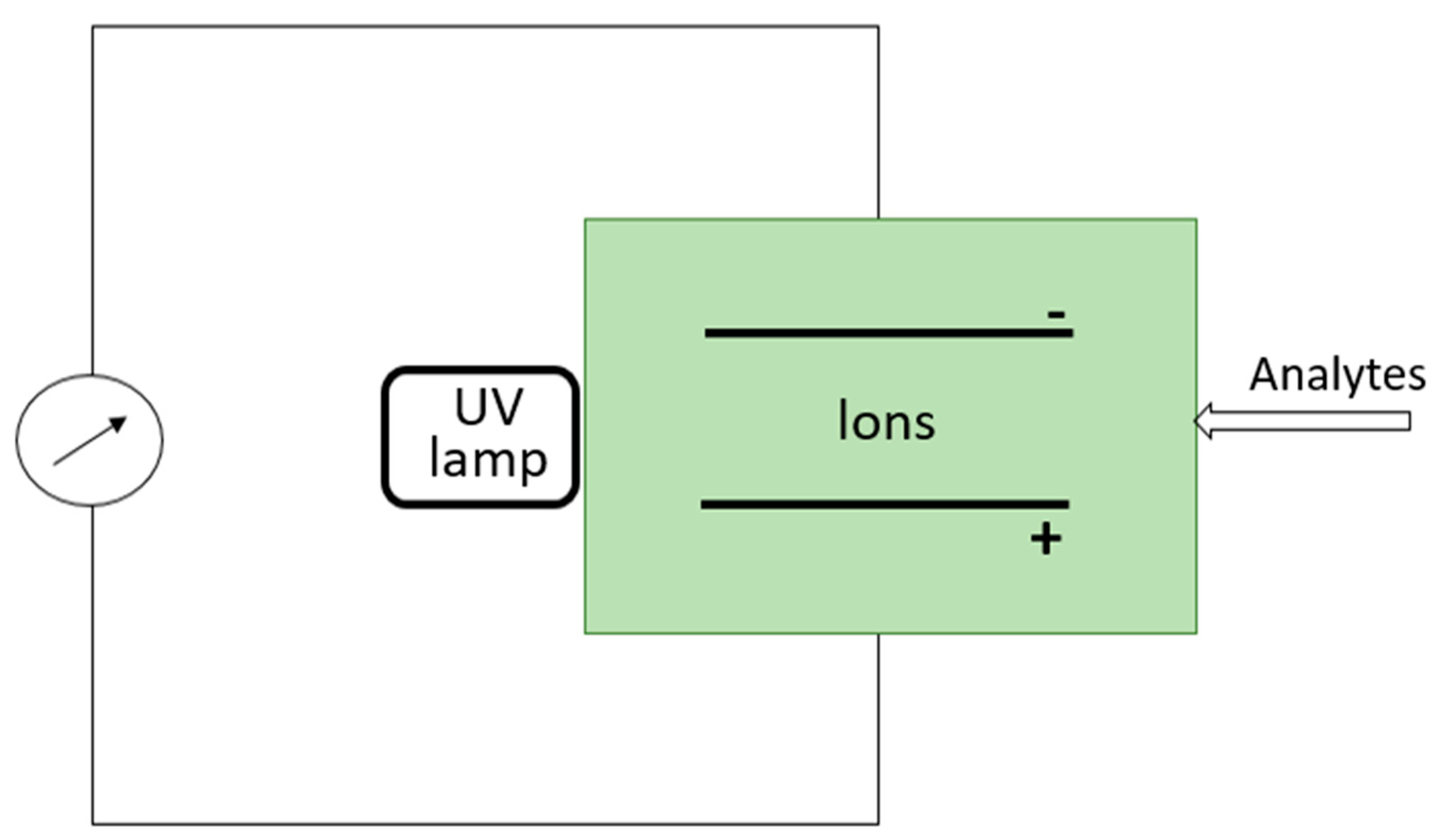
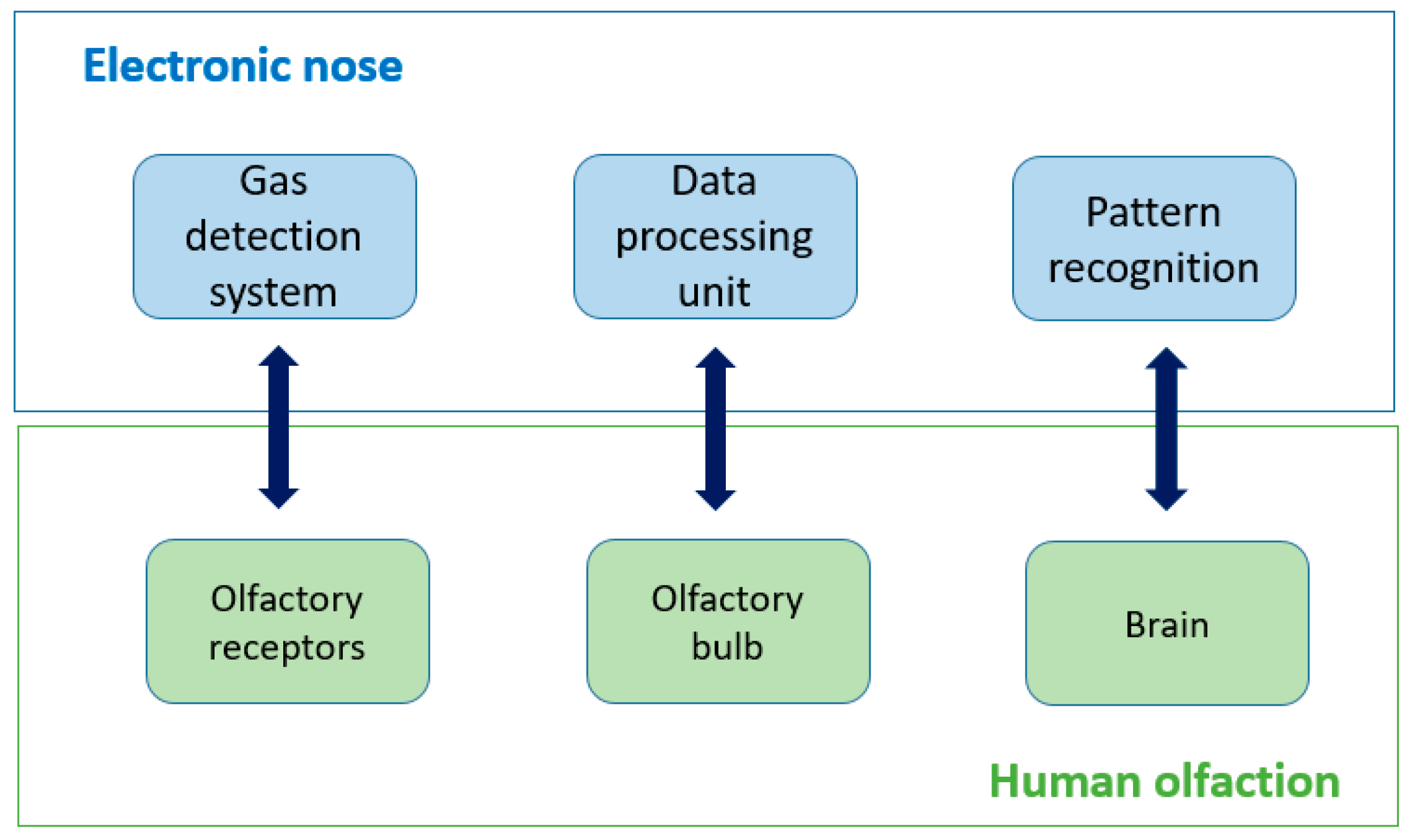
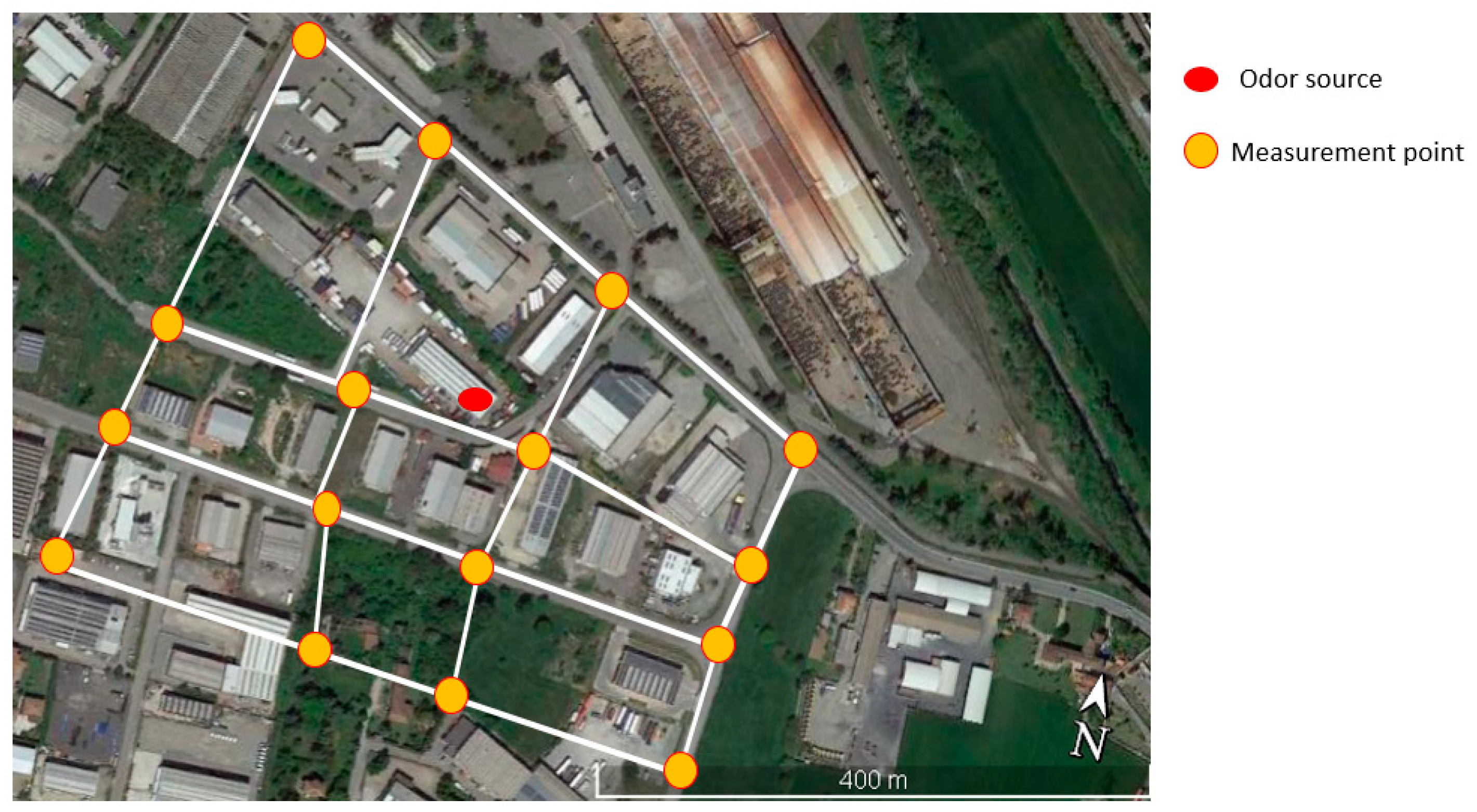
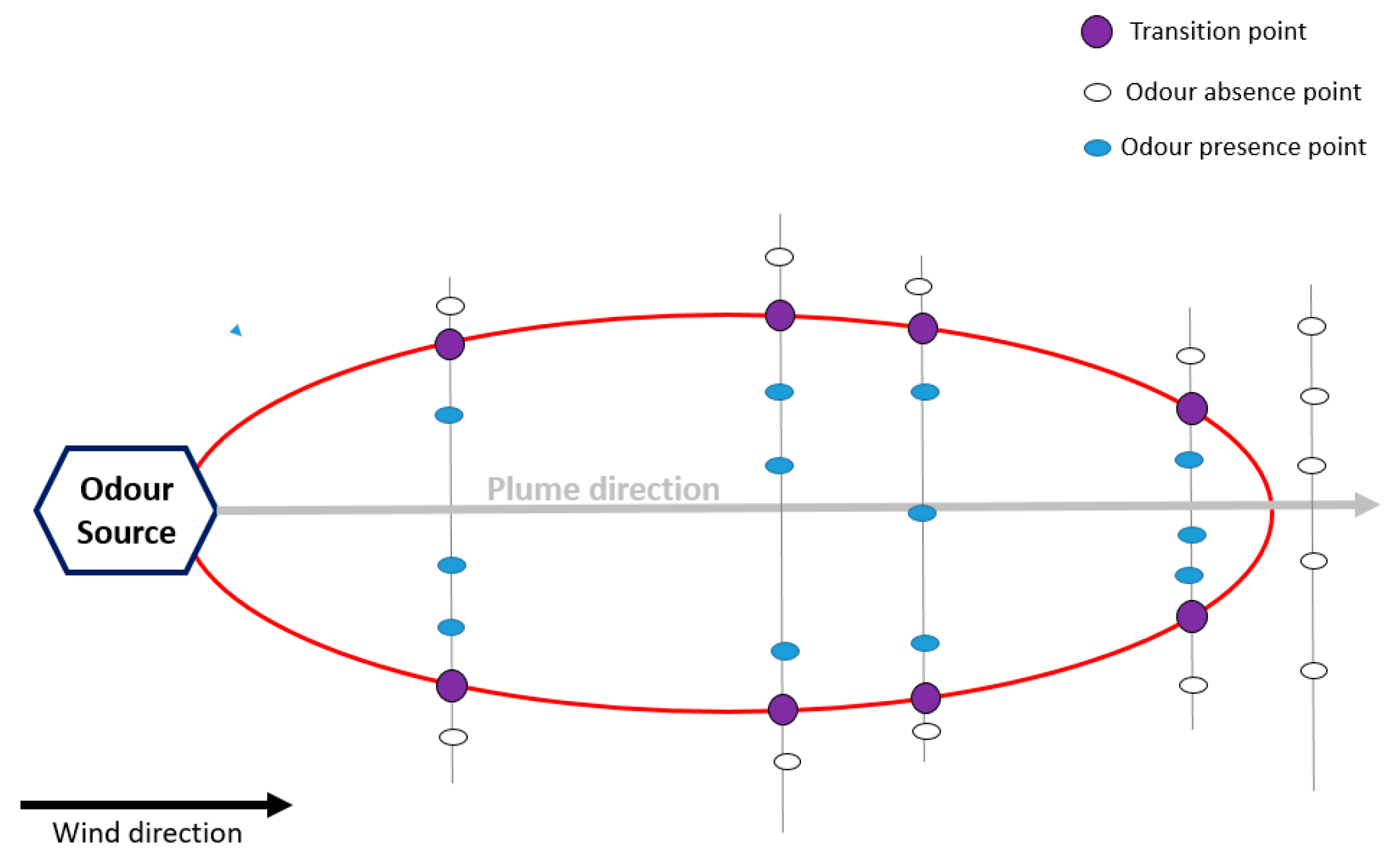

| Measurement Method | Level of Applicability | Applicability | Limitations |
|---|---|---|---|
| Dynamic olfactometry | Emissions | Measures the concentration of odors emitted at the source; verification of compliance with regulatory limits; Provides information that can be used as input data for dispersion modelling in order to evaluate citizens’ exposure to odors | Discontinuous method; No information about quality or hedonic tone of odors; No information about the presence of odors in ambient air (emissions) |
| Chemical analysis—with speciation | Emissions and/or ambient air | Provides information about the chemical composition of odors; Identification and quantification of the chemical compounds detected that can be used for the evaluation of the impact on the environment and human health | Not always effective, especially in the characterization of complex odors, because of synergistic and masking effects between odorants; Hardly estimable correlation between the chemical composition and odor concentration of the mixture; Less sensitive than the human nose for malodorous compounds with a low odor threshold |
| Gas-chromatography-olfactometry (GC-O) | Emissions | Gain information about the odor character associated with the different molecules contained in an odor sample, and thus odor quality; High sensitivity: The human nose is more sensitive than an instrumental detector | No information about the odor concentration of the sample: Because of the separation of the sample in its single components, the olfactory properties of the sample as a whole are not considered; Cannot provide information about the odor impact, and neither can it be used directly as input for dispersion modelling |
| Chemical analysis—non-specific | Emissions | Detection of gas leaks, which are potentially associated with diffuse or fugitive odor emissions | No information about odor properties of the analyzed gas |
| Chemical analysis—single gases | Emissions and/or ambient air | Quantification of the concentration of single gases in emissions or ambient air; Estimation of the odor concentration in emissions, in those rare cases in which the emitted odor is directly correlated to tracers; Measures the impact of the odor in ambient air, in those rare cases in which the odor is directly correlated to tracers and the source can be uniquely identified | Useless in the case of complex odorous mixtures, whereby the odor concentration is not related to the concentration of one single component; No information about the composition of complex mixtures |
| Instrumental odor monitoring (E-noses) | Emissions and/or ambient air | Continuous and fast results with a limited budget; Continuous measurement of the odor concentration at emissions, e.g., for continuous monitoring of odor abatement systems efficiency; Direct determination of the odor impact at receptors and identification of the odor provenance | No information about odor intensity and hedonic tone; Cannot substitute dynamic olfactometry |
| Field inspections | Ambient air | Estimates the degree of annoyance in terms of odor hours in a determined problematic area (grid method); Determines the extent of the odor plume from a facility under specific meteorological conditions (plume method); With suitable training, assessors may provide information about the odor quality | No information about the odor concentration Time-consuming and expensive (grid method) |
| Citizen science | Ambient air | Active citizens’ involvement in the mapping and management of odor problems; Estimation of the degree of annoyance by directly referring to the effect on citizens | Risk of biased information; Hardly applicable in conflictual situations (e.g., lawsuits);High variability of results |
© 2020 by the authors. Licensee MDPI, Basel, Switzerland. This article is an open access article distributed under the terms and conditions of the Creative Commons Attribution (CC BY) license (http://creativecommons.org/licenses/by/4.0/).
Share and Cite
Bax, C.; Sironi, S.; Capelli, L. How Can Odors Be Measured? An Overview of Methods and Their Applications. Atmosphere 2020, 11, 92. https://doi.org/10.3390/atmos11010092
Bax C, Sironi S, Capelli L. How Can Odors Be Measured? An Overview of Methods and Their Applications. Atmosphere. 2020; 11(1):92. https://doi.org/10.3390/atmos11010092
Chicago/Turabian StyleBax, Carmen, Selena Sironi, and Laura Capelli. 2020. "How Can Odors Be Measured? An Overview of Methods and Their Applications" Atmosphere 11, no. 1: 92. https://doi.org/10.3390/atmos11010092
APA StyleBax, C., Sironi, S., & Capelli, L. (2020). How Can Odors Be Measured? An Overview of Methods and Their Applications. Atmosphere, 11(1), 92. https://doi.org/10.3390/atmos11010092







